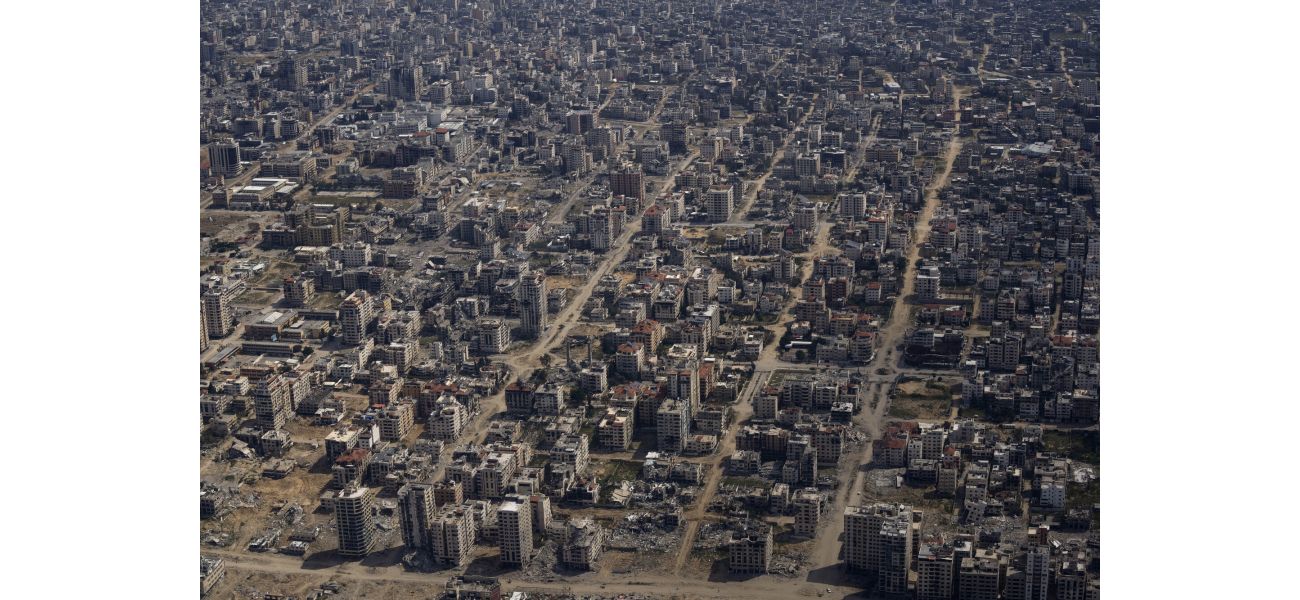UN estimates it could take 350 years to reconstruct Gaza.
Rebuilding would have to wait as decomposing bodies and unexploded weapons need to be removed from the mountains of rubble first.
October 23rd 2024.

According to a recent report released by the United Nations Conference on Trade and Development, the Gaza Strip may take centuries to recover from the devastating effects of the ongoing conflict between Israel and Hamas. This is a far cry from previous estimates that had predicted decades of rebuilding efforts.
Before the war, Gaza was already struggling under a blockade imposed by Israel and Egypt in response to Hamas' takeover in 2007. This, coupled with several previous wars and internal divisions within the Palestinian government, had taken a heavy toll on the territory's economy. However, the current conflict has brought about unparalleled levels of destruction, with entire neighborhoods reduced to rubble and critical infrastructure left in ruins. The sheer magnitude of this devastation means that even in the best-case scenario, it would take a considerable amount of time to clear the debris and begin rebuilding.
In fact, the report states that even if a ceasefire were to be reached immediately and the status quo was restored, it would take 350 years for Gaza's economy to return to its pre-war level. This projection is based on the GDP growth rate that Gaza had experienced from 2007 until 2022. The report also highlights that even if this growth trend were to continue, it would still take an incredibly long time for Gaza to recover, and the GDP per capita would continue to decline as the population grows.
When asked about the calculation, Rami Alazzeh, the author of the report, explained that it was based on the decimation of the economy during the first seven months of the war and the time it would take to restore it at the pre-war growth rate. He emphasized that this was not a prediction but rather a reflection of the conditions under which the recovery would take place. Alazzeh clarified that the aim of the report was not to suggest that it would take 350 years for Gaza to recover, as that would essentially mean that recovery was impossible.
The World Bank had estimated the damage caused by the conflict to be around $18.5 billion, which is equivalent to the combined economic output of the West Bank and Gaza in 2022. However, this was before the intense ground operations carried out by Israel, which resulted in even more destruction. A U.N. assessment from September found that 25% of all structures in Gaza had been destroyed or severely damaged, and around 66% of structures, including more than 227,000 housing units, had sustained some level of damage.
The report also sheds light on the estimated time it would take to rebuild the homes that were destroyed during the conflict. Under the Gaza Reconstruction Mechanism, a process established after the 2014 war to facilitate reconstruction under Israeli surveillance, it would take 40 years to rebuild all the homes. However, even under the most optimistic scenarios, Gaza's recovery would still take decades. The report states that assuming no military operations, free movement of goods and people, and significant investment, it would take until 2050 for Gaza's GDP per capita to return to its 2022 level.
The U.N. Development Program's report released on Tuesday also suggests that the Palestinian economy, including the West Bank, could be back on track by 2034 with major investments and the lifting of economic restrictions. However, in the absence of these factors, their predictions align with those of the UNCTAD report. Unfortunately, the likelihood of these more positive scenarios seems slim.
The ongoing conflict, which began when Hamas-led militants killed 1,200 people, mostly civilians, and abducted another 250 during their attack on Israel in October 2023, shows no signs of ending. The Israeli offensive has resulted in the deaths of over 42,000 Palestinians, according to local health officials. This has led to the displacement of approximately 90% of Gaza's population, with hundreds of thousands forced to live in overcrowded and unsanitary tent camps.
The blockade imposed by Israel to prevent Hamas from importing arms is another major obstacle to Gaza's recovery. Israeli Prime Minister Benjamin Netanyahu has made it clear that they will maintain control over the territory until Hamas is no longer a threat. This means that even if a ceasefire were to be reached, it is highly unlikely that the blockade would be lifted, making it challenging to bring in essential supplies and aid.
Moreover, international donors are hesitant to fund the rebuilding efforts in Gaza as long as the conflict persists or the territory remains under Israeli occupation. Arab Gulf states like Saudi Arabia and the United Arab Emirates have stated that they will only provide financial assistance if there is a clear path towards a Palestinian state, something that Netanyahu strongly opposes. This means that even if a ceasefire is reached, the road to recovery will be a long and arduous one for the people of Gaza.
In the end, it is clear that the repercussions of this ongoing conflict will be felt for generations to come. As Rami Alazzeh put it, "If we go back to where it was before, and we shouldn't go back to the way it was before, then I think it means that Gaza's done." The sheer scale of destruction and the ongoing blockade make it challenging for Gaza to rebuild and move towards sustainable development. The only hope is that a lasting solution can be reached, and the people of Gaza can finally begin to rebuild their lives.
Before the war, Gaza was already struggling under a blockade imposed by Israel and Egypt in response to Hamas' takeover in 2007. This, coupled with several previous wars and internal divisions within the Palestinian government, had taken a heavy toll on the territory's economy. However, the current conflict has brought about unparalleled levels of destruction, with entire neighborhoods reduced to rubble and critical infrastructure left in ruins. The sheer magnitude of this devastation means that even in the best-case scenario, it would take a considerable amount of time to clear the debris and begin rebuilding.
In fact, the report states that even if a ceasefire were to be reached immediately and the status quo was restored, it would take 350 years for Gaza's economy to return to its pre-war level. This projection is based on the GDP growth rate that Gaza had experienced from 2007 until 2022. The report also highlights that even if this growth trend were to continue, it would still take an incredibly long time for Gaza to recover, and the GDP per capita would continue to decline as the population grows.
When asked about the calculation, Rami Alazzeh, the author of the report, explained that it was based on the decimation of the economy during the first seven months of the war and the time it would take to restore it at the pre-war growth rate. He emphasized that this was not a prediction but rather a reflection of the conditions under which the recovery would take place. Alazzeh clarified that the aim of the report was not to suggest that it would take 350 years for Gaza to recover, as that would essentially mean that recovery was impossible.
The World Bank had estimated the damage caused by the conflict to be around $18.5 billion, which is equivalent to the combined economic output of the West Bank and Gaza in 2022. However, this was before the intense ground operations carried out by Israel, which resulted in even more destruction. A U.N. assessment from September found that 25% of all structures in Gaza had been destroyed or severely damaged, and around 66% of structures, including more than 227,000 housing units, had sustained some level of damage.
The report also sheds light on the estimated time it would take to rebuild the homes that were destroyed during the conflict. Under the Gaza Reconstruction Mechanism, a process established after the 2014 war to facilitate reconstruction under Israeli surveillance, it would take 40 years to rebuild all the homes. However, even under the most optimistic scenarios, Gaza's recovery would still take decades. The report states that assuming no military operations, free movement of goods and people, and significant investment, it would take until 2050 for Gaza's GDP per capita to return to its 2022 level.
The U.N. Development Program's report released on Tuesday also suggests that the Palestinian economy, including the West Bank, could be back on track by 2034 with major investments and the lifting of economic restrictions. However, in the absence of these factors, their predictions align with those of the UNCTAD report. Unfortunately, the likelihood of these more positive scenarios seems slim.
The ongoing conflict, which began when Hamas-led militants killed 1,200 people, mostly civilians, and abducted another 250 during their attack on Israel in October 2023, shows no signs of ending. The Israeli offensive has resulted in the deaths of over 42,000 Palestinians, according to local health officials. This has led to the displacement of approximately 90% of Gaza's population, with hundreds of thousands forced to live in overcrowded and unsanitary tent camps.
The blockade imposed by Israel to prevent Hamas from importing arms is another major obstacle to Gaza's recovery. Israeli Prime Minister Benjamin Netanyahu has made it clear that they will maintain control over the territory until Hamas is no longer a threat. This means that even if a ceasefire were to be reached, it is highly unlikely that the blockade would be lifted, making it challenging to bring in essential supplies and aid.
Moreover, international donors are hesitant to fund the rebuilding efforts in Gaza as long as the conflict persists or the territory remains under Israeli occupation. Arab Gulf states like Saudi Arabia and the United Arab Emirates have stated that they will only provide financial assistance if there is a clear path towards a Palestinian state, something that Netanyahu strongly opposes. This means that even if a ceasefire is reached, the road to recovery will be a long and arduous one for the people of Gaza.
In the end, it is clear that the repercussions of this ongoing conflict will be felt for generations to come. As Rami Alazzeh put it, "If we go back to where it was before, and we shouldn't go back to the way it was before, then I think it means that Gaza's done." The sheer scale of destruction and the ongoing blockade make it challenging for Gaza to rebuild and move towards sustainable development. The only hope is that a lasting solution can be reached, and the people of Gaza can finally begin to rebuild their lives.
[This article has been trending online recently and has been generated with AI. Your feed is customized.]
[Generative AI is experimental.]
0
0
Submit Comment





